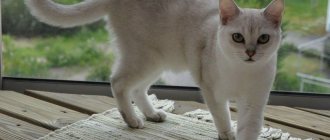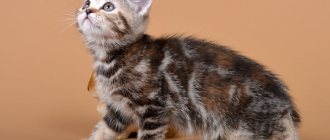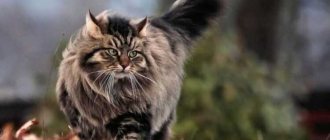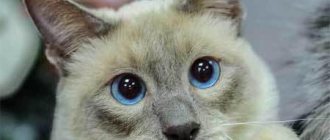Brief history of the breed
Laperms appeared relatively recently due to a mutation that occurred in the genotype of an ordinary cat. In 1982, a mongrel female named Speedy, who lived in Dallas with farmers Linda and Richard Coel, gave birth to six kittens. One of them was very different from the rest. It had curled whiskers, wide-set ears and an elongated bald body with striped skin.
By the end of the second month, the kitten began to grow soft, wavy hair, and soon its body was completely covered with a curly fur coat. For this feature, the cat was named Curly (“curly”).
She later became the mother of five kittens with wavy fur. Over the next 10 years, curly-haired individuals were periodically born on the farm. And when there were too many unusual animals, the Coel spouses turned to felinologists with an application for their consideration.
In 1992, Laperm cats first appeared at an exhibition in Portland. From that moment on, their breeding became targeted. In 2002, curly-haired cats were registered with the TICA association, and 6 years later the Laperm breed received official recognition from the CFA.
Origin
The breed was formed due to a mutation in the 80s of the twentieth century. Breeders did not breed it on purpose, and in the first years of its existence, individuals reproduced independently and crossed with other varieties.
The first representative appeared in the state of Oregon in an ordinary domestic cat named Speedy. The newborn kitten was completely hairless, but two months later it was covered with wavy hair, which has never been typical for cats. The baby was named Curly. The genetic defect turned out to be a recognizable feature of the pet and began to be passed on to descendants, who formed the Laperm breed.
Interesting Facts
Despite the relative youth of the breed, a lot of interesting things have been associated with Laperms:
- The research revealed that the gene responsible for curly hair is dominant. It can be carried by both females and males.
- The name of the breed reflects the main feature of curly cats. It consists of two parts: the French article la and the English word perm, which translates as “permanent wave.”
- Laperms are characterized by heavy shedding, during which curly-haired cats completely lose their fur.
- The name of the breed has 2 spellings: la-perm and laperm.
Breeding cats La Perm
Any colors are acceptable. Until 2010, crossbreeding with domestic shorthair and longhair, preferably American breeds, was allowed. Since January 2010, only representatives of the Laperm breed are allowed.
Breed LaPerm kitten (photo)
Laperm kittens are born with short fur or hairless. Starting at 2 weeks of age, they molt several times until a curly coat is formed by 4 months.
Breed LaPerm kittens (photo)
Breed description, standards, appearance
Laperms are flexible, proportionally built, curly cats that cannot be confused with any other breed. They have soft curly fur and expressive facial expressions, which allows you to clearly read their emotions.
A detailed description of the breed is presented in the generally accepted standard.
Dimensions and weight
Laperm cats are not large in size. The standard clearly regulates the maximum weight of these animals. According to the official document, the weight of a curly cat should not exceed 4 kg. A cat can weigh up to 5-5.5 kg.
Anatomical characteristics
A thoroughbred laperm must meet the following description:
- The head is triangular, with smoothly defined corners, a wide muzzle, a strong chin and a flat forehead. The whisker pads are rounded, the whiskers are flexible and long.
- The eyes are almond-shaped, widely spaced. The color of the iris does not depend on color and can be yellow, green, copper, blue or light blue. Heterochromia is also allowed in curly-haired cats.
- The ears are medium or large in size, wide, cup-shaped. The inner part is slightly pubescent. The ears of long-haired laperms are decorated with fluffy tassels.
- The body is proportional, moderately elongated, with a slightly raised croup.
- Limbs of medium length. Moreover, the front ones are slightly shorter than the rear ones. The paws are compact and graceful.
- The tail is long, gradually tapering towards the tip.
Color and coat type
The breed is divided into varieties depending on the length of the guard hair. Laperm happens:
- short-haired;
- long-haired
In both cases, the cat's body is covered with a light springy spine, forming waves and curls.
On a note. Curly hair on the Laperm's body appears at 4-6 months. Until this age, the kitten remains smooth-haired or completely hairless.
The color of laperma can be varied. The standard allows for more than 30 color variations. But most often the following colors are found in the breed:
- cinnamon;
- black;
- chocolate;
- white;
- ginger;
- ivory.
Read in detail - all about curly cat breeds.
On a note. Black laperms have a charcoal-colored nose and paw pads. In other representatives of the breed, these parts of the body are colored pink.
Possible breed defects
Flaws in appearance, in the presence of which a curly cat will not receive a high expert rating:
- stripes on the body;
- too thin wool;
- insufficiently thick hair.
Defects due to which a Laperm cat may be disqualified:
- short limbs;
- loose constitution;
- polydactyly;
- cryptorchidism (in males);
- alopecia;
- strabismus;
- straight hair in individuals older than 12 months.
Laperm: kitten price
Increasingly, Russian cat lovers are showing interest in the original appearance of Laperms, and on forums “cat lovers” are curious about how much a Laperm costs, usually becoming disappointed due to the difficulties of purchasing an animal of this breed. But many, on the contrary, awaken an interest in sports, and they, at all costs, are eager to acquire the treasured cat. The high price of a laperm kitten, endowed with surprisingly curly long hair, also causes despair among potential buyers. The cost of kittens, depending on external characteristics, ranges from $500 to $4,500.
Character and temperament
Laperms are affectionate and sociable curly cats. They quickly become attached to their owners and love to spend time around people. Cats of this breed express their tenderness and gratitude through quiet purring and touching. They love to sit on their owner's lap or shoulders.
The friendly and non-conflict nature of Laperms allows them to easily find a common language with children. Curly-haired cats respect their owners' babies and willingly play with them.
Friendly lapermas get along easily with other pets. Moreover, they are loyal not only to their relatives, but also to non-aggressive dogs.
Characteristics of Laperm cats
The main feature of La Perm pets is their attachment to their owner. Animals love human company. They express their love and appreciation through touching and purring. The affectionate cat prefers to sit in your arms or climb onto your shoulders and chest. At the same time, the animal can gently touch the person’s face with its paw, thereby expressing its endless love.
Most pets have a quiet voice, although sometimes they can raise their intonation, demanding attention. But this call will never be too loud and annoying. The LaPerm cat quickly responds to its name and readily comes running when called.
While in the house, cats show dexterity and resourcefulness - they are active rodent hunters. Perhaps they inherited this quality from their ancestors who lived in semi-natural conditions on an American farm.
If children grow up in a family, then Laperma kittens will be welcome members of the family. Pets of this breed readily show a desire to play and, when treated with respect, always behave calmly and friendly. This trait also manifests itself in getting along with other pets in the house.
Kotofeys often show ingenuity and intelligence. This can be expressed not only in rapid training to the tray, but also in the ability to open doors, drawers, boxes and other closed objects. Curiosity and mobility often lead curly pets to high shelves and cabinets. Therefore, if Laperm cats live in the house, it is recommended to remove all expensive and breakable items from the upper shelves.
How to choose the right kitten
It is better to buy laperma from a trusted breeder or in a specialized nursery. At the time of sale, the kitten must have documents confirming its purebred and vaccinations. Before purchasing, it is advisable to evaluate the living conditions of the children and observe their behavior.
Laperma kittens should have slanted eyes, large ears, a sharp chin and soft fur that feels like padding polyester. The state of their health can be judged by their soft belly, smooth skin, lack of unpleasant odor from the mouth and dirt under the tail.
Kitten care
Responsible breeders wean kittens from their mother no earlier than 12 weeks. Since at this age little lapermas already eat on their own, know how to use a scratching post and are accustomed to a tray, caring for them is not particularly difficult. New owners can only give the kitten time to adapt and show where its bowls, bed and toilet are located.
In order not to expose the little Laperm to unnecessary stress, at first he is fed what he ate from the breeder. New foods are introduced into the kitten’s diet gradually, while the reaction of its body is carefully monitored.
The feeding regimen depends on the age of the laper:
- up to 3 months – 5 times a day;
- 3-6 months – 4 times a day;
- 6-12 months – 3 times a day.
Adult laperms are fed twice a day.
Care and maintenance
Due to the lack of thick down, lapermas will not be able to live on the street. Caring for cats of this breed comes down to trimming their claws and keeping their fur, eyes, ears and mouth clean.
Laperma teeth are cleaned regularly with a silicone brush and a small amount of non-foaming toothpaste. This simple procedure will keep your cat’s fangs white and will prevent the formation of stones.
The laperma's eyes and ears are wiped daily with a cotton pad moistened with boiled water and inspected for the presence of unusual discharge.
The claws of a curly-haired cat are shortened 2-3 times a month with a nail clipper, trying to be extremely careful so as not to injure living tissue.
To keep the Laperm's fur looking neat and not tangled, it is combed weekly with a wide-toothed comb. And to maintain cleanliness, a curly cat is regularly bathed using special shampoos.
On a note. It is not recommended to dry wet Laperma wool with a hairdryer, so as not to spoil the curls.
Description
Cats of the breed are medium in size and not small or small. Breed standard: muscular body, medium in size, with long legs and neck. The head is wedge-shaped, slightly rounded at the sides.
The nose is straight, ears set wide apart and large, almond-shaped eyes. Cats weigh from 2.5 to 4 kg, and mature quite late, about 2 years.
The main feature is their unusual coat, which can be of any color, but the most common are tabby, red and tortoiseshell. Also popular are lilac, chocolate, and color point.
Six does not feel silky to the touch, but rather resembles mohair. It is soft, although in short-haired lapermas it can seem quite harsh.
The undercoat is sparse, and the coat itself is loose and loosely adjacent to the body. It is light and airy, so at shows, judges often blow on the wool to see how it separates and assess its condition.
Feeding the cat
Laperma can be given both industrial and natural food. In the first case, the curly-haired cat is fed premium or super-premium class dry food, which contains all the necessary microelements and does not contain any questionable additives.
These requirements are best met by:
- Royal Canin;
- Monge;
- Bosch;
- Brit Care.
When feeding natural products, the Laperm diet is thought out so that it is based on lean, fresh meat. Also included in the menu for curly cats:
- boiled vegetables;
- porridge with water;
- eggs;
- dairy products;
- lean sea fish;
- offal.
Cats of this breed should not be fed bones, sweets, baked goods, sausages or whole milk. Laperms are also forbidden to give river fish, smoked meats, pickles and any food from the master’s table.
Nutrition
They are not picky about food, they can happily eat both food from the owners’ table and store-bought food.
If the Laperms are fed with natural food, care must be taken to ensure that the diet is balanced; the menu includes:
- vitamin supplements;
- minerals;
- macro- and microelements.
When grooming itself, the animal licks its fur, and hairs fall into the stomach.
Therefore, the food must contain ingredients that help remove hair from the stomach:
- cellulose;
- prebiotics;
- probiotics.
LaPerm cats are not prone to obesity, but you should not overfeed them so as not to cause obesity.
Education and physical activity
Laperms are highly intelligent cats that are highly trainable. They quickly get used to a certain routine and understand how to use the tray and scratching post. Curly-haired cats, like dogs, come running when called by their owner and can perform simple tricks.
Agile and resourceful, Laperms have an active temperament and easily jump onto high cabinets and shelves. To realize their hunting instincts, it is advisable for cats of this breed to buy interactive toys and set up a play corner.
Vaccinations and antiparasitic treatment
To prevent viral and infectious diseases, curly-haired cats are regularly vaccinated with a complex drug that helps develop stable immunity:
- to panleukopenia;
- rhinotracheitis;
- calcivirus.
The first vaccination is given to a kitten at the age of 7-8 weeks. After 4 weeks, the animal is vaccinated again, but with an anti-rabies component. In the future, Laperma is vaccinated once a year.
To prevent infection with diseases carried by fleas and worms, curly-haired cats are regularly treated with antiparasitic treatments. She is given anthelmintic drugs 2 times a year with mandatory repetition after 10-14 days.
To combat fleas, special drops and shampoos are used. And if a curly-haired cat regularly goes for walks, she is additionally protected with an anti-parasitic collar.
Health and life expectancy
In general, the breed is healthy, there are no genetically transmitted diseases. This is due to the spontaneous occurrence of Laperm and the use of strong phenotypes of cats to strengthen the breed characteristics. However, parasitic infestations (fleas, ticks, helminths, etc.) may occur. Allergic reactions rarely occur. Lapermas can suffer from infectious viral and bacterial diseases, as well as diseases caused by single-celled protozoa.
This is interesting! With proper care, pets live up to about 15 years. Some pets live longer.
Death can be caused by congenital malformations (extremely rare), serious viral diseases, parasitic infestations and associated diseases, and dangerous injuries. Improper maintenance, poor and unbalanced nutrition can also shorten life expectancy.
Cats need to be given enough attention; in adolescence, good socialization is required, otherwise pets may suffer psychologically, which is expressed in depression, which is not typical for this breed.
Pros and cons of the breed
Laperms, like cats of any other breed, have both advantages and disadvantages.
| pros | Minuses |
| Interesting appearance | Grooming needs |
| Affectionate character | Excessive curiosity |
| Good health | High cost of kittens |
Laperms are exquisite curly-haired cats with a gentle, easy-going disposition. They require minimal care and pay for a caring attitude with selfless love and devotion.
Varieties, their features and differences
LaPerm is a young, established breed of cat that has some varieties. There are long-haired and short-haired Laperms. Both options are approved by world felinological associations, are equally relevant to the breed and are acceptable, like the Kuril, American or Mekong Bobtail.
Longhair
Long-haired representatives of the breed have softer and lighter hair, and the coat looks more disheveled. A parting may form on the back along the spine. There are often tassels on the ears, but their presence is not necessary. Long-haired LaPerms with a fluffy, curly collar are also common. The fur all over the body can lie in beautiful waves or curl down to small curls. The fur is especially lush on the tail.
Shorthair
Short-haired pets have a stiffer and denser coat. The hair curls more intensely, and representatives of this type of breed are somewhat similar to Rex. In general, the hair is elastic and loosely adheres to the body. There are no tufts on the ears; the hair on the tail is also more luxuriant and curly, bristling as much as possible. Unlike their long-haired relatives, guard hairs grow mainly on the belly and back.
Long-haired and short-haired LaPermas do not differ in body type. Their appearance is formed mainly by hair. Both representatives of the breed are sophisticated cats, they have the same posture and appearance.











